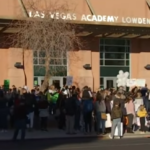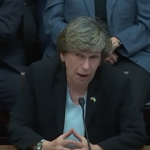Mao’s Cultural Revolution Bred Capitalism
 Editor’s Note: Maybe the ‘May Day’ activists need a refresher course in socialism.
Editor’s Note: Maybe the ‘May Day’ activists need a refresher course in socialism.
Mao Zedong’s Cultural Revolution during the 1960s was a disastrous failure and it created a capitalist society in rural China, noted one professor at an event held by the libertarian think tank Cato Institute. Humanities professor Frank Dikotter, who works at the University of Hong Kong, noted how capitalism sprang up from the ashes of the Cultural Revolution, where millions were killed by Mao’s communist regime.
The Cultural Revolution didn’t spontaneously appear, Dikotter said, as others believe. In fact, the Cultural Revolution began in 1962 until 1966, where a “socialist education campaign enforced by Mao” took place in Chinese schools. Dikotter pointed out, “in a nutshell, Mao does something that no one has ever done in a one-party state. He used the people to attack the party.” The Cultural Revolution’s Red Guards appeared in 1966 and did not come out of nowhere, but were direct results of Mao’s education campaign. From 1968-1971, Dikotter called this “a military dictatorship” and the “Black Years” of China because “it was such an awful garrison state where the majority of the unnatural deaths accounted for the Cultural Revolution happened.” He continued, “Far more people were killed by the military than the Red Guards in 1966.” The last part of the Cultural Revolution was Dikotter’s “Gray Years,” where “people see how the party has become and use that opportunity to connect with the past.”
Why did Mao create the Cultural Revolution? The rise of Khrushchev in the Soviet Union spurred Mao’s actions because Khrushchev was critical of Josef Stalin. “Mao views Khrushchev’s attack on Stalin as an attack on himself; he was Stalin’s student,” said Dikotter. Mao believed that although the “bourgeoisie was gone, but the bourgeoisie culture was still around.” Mao concluded, “A thought revolution was needed against all treasures of the past,” as Dikotter noted. This “sweep against bourgeoisie culture” was in part spurred by Mao being “very concerned about shoring up his own reputation” within his own party, his country and in socialist circles in general. Mao saw “himself as a revolutionary,” Dikotter said, “a greater revolutionary figure than Khrushchev.”
The Great Leap Forward demonstrated this belief put into action, where people were herded into communes where Mao desired a people’s army. He firmly believed that “the economy of China could be catapulted past” their competitors and allies. Dikotter averred, “We know what happened; it was a disaster. [It] led to the death of tens of millions of people” in China. This fed into the Cultural Revolution because it was “Mao’s second attempt to become the pivot around which the socialist universe revolved.”
“Lenin,” Dikotter said, “in 1917, carried out the Great October Revolution. Now, Mao will carry out the Great Proletarian Revolution.” Mao was also worried “about people who might denounce him during his own life” after Khrushchev denounced Stalin. “Mao was seething,” said Dikotter, after fellow party members like Deng Xiaoping criticized him and his goals. “Many thought that Mao was responsible for the mass starvation of ordinary people” in the Great Leap Forward. Mao’s question was, “Who would be China’s Khrushchev?”
Mao’s “socialist education campaign” started in 1962 and was meant to “heighten vigilance of past enemies [and] make sure collectivism is maintained.” “But,” Dikotter said, “Repression is not enough” for Mao and his indoctrinated students. “Students have been indoctrinated in class hatred for two, three or four years,” Dikotter pointed out, “itching to get out to find those bourgeoisie elements” in Chinese society.
These motivated socialist Chinese students became extreme and some were punished because they went too far, yet they described their impure ideological peers as “anti-socialist reactionaries.” Then, the Red Guard appeared as these students donned military uniforms and “millions are sent to the countryside as the military tore up this garrison state.” These “students sent to the countryside to be re-educated by peasants.” This led to talk “about traitors, spies, renegades” and then “special committees are set up” in China. For example, in Shanghai, “some 170,000 people are implicated in this witch hunt” and “some 40,000 people are killed during this purge” in Shanghai.
In Inner Mongolia, “some 800,000 people are imprisoned, interrogated…torture chambers appear in Inner Mongolia.” Dikotter mentioned some torture techniques, such as “tongues ripped out” and other gruesome tactics, where “it looks very much like a genocide” of Mongolians. Dikotter explained that “75% of victims are Mongols, but comprise only 10% of Inner Mongolia.”
After this exhaustive revolution, the people were tired. “They realized the party has been badly damaged by the Cultural Revolution,” Dikotter said. Then, “millions upon millions of people, as I refer to as a silent revolution, start recollecting with the past,” he noted. “They realized there is an opportunity here, not to oppose the party, but to reconnect with the past.”
In one province in China called Shaanxi, which was Mao’s old revolutionary capital, the people began to rebel. “They redistribute collective assets,” Dikotter said, “they start operating factories” under the government’s noses. When government inspectors arrive some years later, “the entire region has gone capitalist.” In Shaanxi, “the land is quietly decollectivized, handed back to individual households.” This bottom-up revolution “followed the entire breadth of the country” from Guangdong up the eastern coast of China and where “everything is traded [and] all forbidden items in a planned economy” can be sold, such as cotton. In these rural provinces, “you see markets appear.”
Dikotter said that the people chose this system “if only to escape from the sheer misery and starvation” that was commonplace in rural Chinese provinces. He said that by 1975, “three-quarters of all [output] comes from factories, not agriculture…truly a revolution from below.”
Photo by randomwire 




